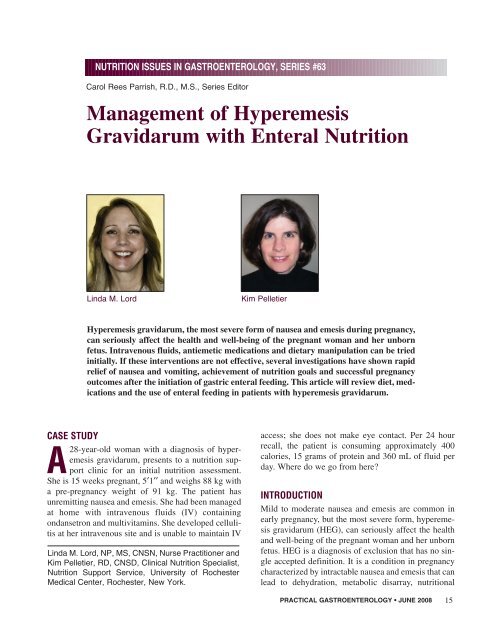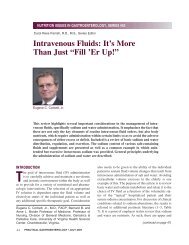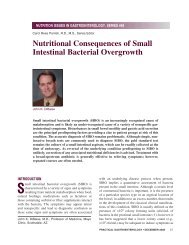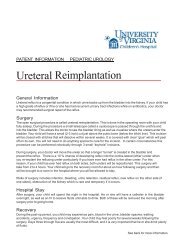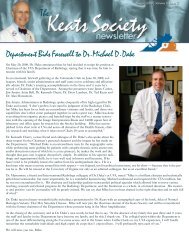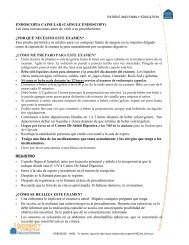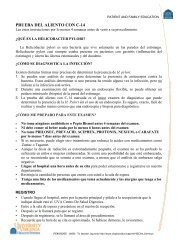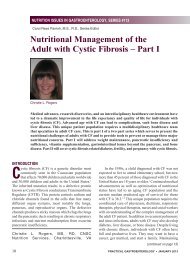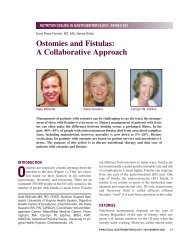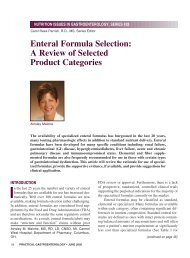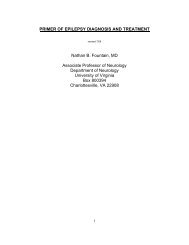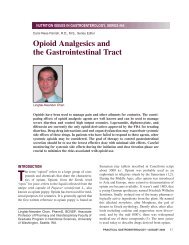Management of Hyperemesis Gravidarum with Enteral ... - Medicine
Management of Hyperemesis Gravidarum with Enteral ... - Medicine
Management of Hyperemesis Gravidarum with Enteral ... - Medicine
Create successful ePaper yourself
Turn your PDF publications into a flip-book with our unique Google optimized e-Paper software.
NUTRITION ISSUES IN GASTROENTEROLOGY, SERIES #63<br />
Carol Rees Parrish, R.D., M.S., Series Editor<br />
<strong>Management</strong> <strong>of</strong> <strong>Hyperemesis</strong><br />
<strong>Gravidarum</strong> <strong>with</strong> <strong>Enteral</strong> Nutrition<br />
Linda M. Lord Kim Pelletier<br />
<strong>Hyperemesis</strong> gravidarum, the most severe form <strong>of</strong> nausea and emesis during pregnancy,<br />
can seriously affect the health and well-being <strong>of</strong> the pregnant woman and her unborn<br />
fetus. Intravenous fluids, antiemetic medications and dietary manipulation can be tried<br />
initially. If these interventions are not effective, several investigations have shown rapid<br />
relief <strong>of</strong> nausea and vomiting, achievement <strong>of</strong> nutrition goals and successful pregnancy<br />
outcomes after the initiation <strong>of</strong> gastric enteral feeding. This article will review diet, medications<br />
and the use <strong>of</strong> enteral feeding in patients <strong>with</strong> hyperemesis gravidarum.<br />
CASE STUDY<br />
A28-year-old woman <strong>with</strong> a diagnosis <strong>of</strong> hyperemesis<br />
gravidarum, presents to a nutrition support<br />
clinic for an initial nutrition assessment.<br />
She is 15 weeks pregnant, 5′1′′ and weighs 88 kg <strong>with</strong><br />
a pre-pregnancy weight <strong>of</strong> 91 kg. The patient has<br />
unremitting nausea and emesis. She had been managed<br />
at home <strong>with</strong> intravenous fluids (IV) containing<br />
ondansetron and multivitamins. She developed cellulitis<br />
at her intravenous site and is unable to maintain IV<br />
Linda M. Lord, NP, MS, CNSN, Nurse Practitioner and<br />
Kim Pelletier, RD, CNSD, Clinical Nutrition Specialist,<br />
Nutrition Support Service, University <strong>of</strong> Rochester<br />
Medical Center, Rochester, New York.<br />
access; she does not make eye contact. Per 24 hour<br />
recall, the patient is consuming approximately 400<br />
calories, 15 grams <strong>of</strong> protein and 360 mL <strong>of</strong> fluid per<br />
day. Where do we go from here?<br />
INTRODUCTION<br />
Mild to moderate nausea and emesis are common in<br />
early pregnancy, but the most severe form, hyperemesis<br />
gravidarum (HEG), can seriously affect the health<br />
and well-being <strong>of</strong> the pregnant woman and her unborn<br />
fetus. HEG is a diagnosis <strong>of</strong> exclusion that has no single<br />
accepted definition. It is a condition in pregnancy<br />
characterized by intractable nausea and emesis that can<br />
lead to dehydration, metabolic disarray, nutritional<br />
PRACTICAL GASTROENTEROLOGY • JUNE 2008 15
<strong>Management</strong> <strong>of</strong> <strong>Hyperemesis</strong> <strong>Gravidarum</strong><br />
NUTRITION ISSUES IN GASTROENTEROLOGY, SERIES #63<br />
compromise, psychological disturbances and termination<br />
<strong>of</strong> the pregnancy. Key to the diagnosis <strong>of</strong> HEG is<br />
the patient’s presentation and onset <strong>of</strong> symptoms that<br />
are consistent <strong>with</strong> this condition. The nausea and<br />
emesis <strong>of</strong> HEG are unrelenting <strong>with</strong> onset between the<br />
fourth and tenth week <strong>of</strong> gestation <strong>with</strong> symptoms<br />
resolving between the fifteen and twenty week <strong>of</strong> gestation.<br />
In some unfortunate cases, it can last the entire<br />
pregnancy (1). Weight loss <strong>of</strong> at least 5% pre-pregnancy<br />
weight is not uncommon. Physical findings <strong>of</strong><br />
abdominal pain, fever, headache, or goiter suggest<br />
other potential diagnoses. The patient should also be<br />
assessed for any chronic condition associated <strong>with</strong><br />
nausea and emesis that preceded the pregnancy. <strong>Management</strong><br />
<strong>of</strong> this condition <strong>with</strong> fluids, pharmacologic<br />
agents and enteral nutrition (EN) support early on will<br />
prevent more severe complications.<br />
INCIDENCE AND RISK FACTORS<br />
Nausea and emesis are common during the first<br />
trimester <strong>of</strong> pregnancy; in fact, they may be the first<br />
sign <strong>of</strong> pregnancy for many women. These symptoms<br />
can occur as early as two weeks gestation and generally<br />
peak between eight and 12 weeks. About 50% <strong>of</strong><br />
pregnant women have some nausea and emesis; 25%<br />
have nausea alone (2). HEG, the most severe form <strong>of</strong><br />
nausea and emesis, occurs in approximately 0.3%–2%<br />
<strong>of</strong> pregnancies (3). Maternal risk factors for HEG<br />
include nulliparity, history <strong>of</strong> HEG in a previous pregnancy,<br />
mothers or sisters <strong>with</strong> HEG, a female fetus, (4)<br />
multiple gestations, increased body weight, or history<br />
<strong>of</strong> motion sickness or migraines (5).<br />
ETIOLOGY<br />
Several factors have been explored as potential causes<br />
for HEG, but the true etiology has yet to be elucidated.<br />
There is a close temporal relationship between onset and<br />
peak circulating levels <strong>of</strong> human chorionic gonadotropin<br />
(hCG) hormone and the development <strong>of</strong> HEG (6). Not<br />
all women develop HEG during pregnancy, possibly due<br />
to the varying biologic activity <strong>of</strong> different hCG is<strong>of</strong>orms<br />
or differences in their susceptibility to an emetogenic<br />
stimulus (7). Serum hCG concentrations tend to be<br />
higher in women <strong>with</strong> HEG who have an increase serum<br />
thyroxine (T4) level. Transient maternal hyperthy-<br />
16<br />
PRACTICAL GASTROENTEROLOGY • JUNE 2008<br />
roidism is seen in about 60% <strong>of</strong> women <strong>with</strong> HEG,<br />
although hyperthyroidism by itself rarely causes vomiting<br />
(8,9). The hyperemesis resolves at the same time that<br />
thyroid levels return to normal, usually by 18 weeks gestation<br />
(10). A possible Helicobacter pylori infection<br />
should be investigated if the nausea and vomiting continues<br />
into the second trimester. One study compared<br />
psychological symptoms in pregnant women <strong>with</strong> and<br />
<strong>with</strong>out HEG during their pregnancy and again postpregnancy<br />
(11). Subjects in the midst <strong>of</strong> HEG symptoms<br />
were shown to have significantly higher psychological<br />
symptoms <strong>of</strong> depression, hysteria, psychasthenia, schizophrenia,<br />
somatization, obsessive compulsive behaviors,<br />
and anxiety than those pregnant women who were not<br />
suffering from HEG. In the post-pregnancy analysis<br />
there was no difference in the psychological scoring <strong>of</strong><br />
patients who had endured HEG compared to those who<br />
had not. The authors attributed the stress and trauma <strong>of</strong><br />
HEG as the cause <strong>of</strong> the psychological symptoms, rather<br />
than the reverse, and concluded that HEG is not a conversion<br />
disorder. It would be hard to prove that HEG is<br />
purely psychological as many women begin to vomit<br />
before they have a missed period or even know that they<br />
are pregnant.<br />
CLINICAL CONSEQUENCES OF<br />
HYPEREMESIS GRAVIDARUM<br />
Physiologic Effects<br />
The emesis, discomfort and decreased appetite that<br />
accompanies HEG interferes <strong>with</strong> caloric and fluid<br />
intake leading to weight loss, dehydration, deteriorating<br />
nutritional state and <strong>of</strong>ten acid base and electrolyte<br />
alterations.<br />
Assessment <strong>of</strong> pregnancy weight changes should<br />
be evaluated after fluid resuscitation. Continued<br />
weight loss during pregnancy should be avoided to<br />
assure that the infant attains a safe, appropriate weight<br />
for its gestational age. HEG symptoms that persist into<br />
the third trimester are associated <strong>with</strong> a higher incidence<br />
<strong>of</strong> low birth weight infants (12). Severe malnutrition<br />
in pregnancy can lead to spontaneous abortion,<br />
teratogenic effects, poor neurological development<br />
and preterm delivery.<br />
(continued on page 19)
(continued from page 16)<br />
Serum albumin levels decline <strong>with</strong> pregnancy,<br />
starting during the first trimester, due to expected fluid<br />
accrual. A mild to moderate ketonuria may be seen and<br />
reflects metabolism <strong>of</strong> fatty acids due to inadequate<br />
caloric and protein intake. Ketones readily cross the<br />
placenta and may impair fetal neuropsychological<br />
development (13).<br />
Thiamine (B 1 ) deficiency has been reported in as<br />
many as 60% <strong>of</strong> HEG patients (14). The woman <strong>with</strong><br />
HEG is prone to thiamine deficiency due to the<br />
increased demand for glucose metabolism, coupled<br />
<strong>with</strong> the inability to tolerate adequate food and vitamin/mineral<br />
supplements. Glucose metabolism is very<br />
active in the pregnant woman due to the hypermetabolic<br />
state <strong>of</strong> pregnancy and the developing fetus’s<br />
energy needs and rapid tissue production. Thiamine<br />
deficiency can result in beri-beri symptoms that<br />
include fatigue, loss <strong>of</strong> appetite, emotional instability,<br />
sleep disturbances and abdominal discomfort.<br />
Advanced neuropathic manifestations <strong>of</strong> beri-beri<br />
include parethesias, weakness, tenderness and cramps<br />
<strong>of</strong> the lower extremities. The cerebral progression <strong>of</strong><br />
thiamine deficiency resulting in Wernicke’s<br />
encephalopathy has been reported in 33 cases in the<br />
past 20 years (7,15). The initiation <strong>of</strong> dextrose containing<br />
intravenous fluids or aggressive nutrition support,<br />
<strong>with</strong>out the provision <strong>of</strong> thiamine, can precipitate<br />
Wernicke’s encephalopathy. Thiamine administration<br />
<strong>of</strong> 100 mg IV or IM daily, or the same dosage enterally<br />
if tolerated, has been suggested for any patient <strong>with</strong><br />
more than three-to-four weeks <strong>of</strong> emesis (16).<br />
HEG can cause a mild increase in liver enzymes<br />
(up to four times the upper limit <strong>of</strong> normal) that return<br />
to normal when the HEG is successfully treated (17).<br />
Serum amylase may rise up to five times greater than<br />
normal, but this is usually salivary and not pancreatic<br />
amylase (18). Excessive retching during HEG may<br />
lead to esophageal rupture, Mallory Weiss tears, pneumothorax<br />
and pneumomediastinum.<br />
Psychosocial Effects<br />
The unremitting physiologic symptoms <strong>of</strong> HEG have<br />
been shown to have a substantial emotional effect on a<br />
woman’s life. A woman <strong>with</strong> HEG <strong>of</strong>ten cannot carry<br />
on <strong>with</strong> her usual work, household, or social activities.<br />
<strong>Management</strong> <strong>of</strong> <strong>Hyperemesis</strong> <strong>Gravidarum</strong><br />
NUTRITION ISSUES IN GASTROENTEROLOGY, SERIES #63<br />
She begins to isolate herself because she has no control<br />
over the vomiting and is embarrassed, fatigued, and<br />
frustrated. One study interviewed hospitalized women<br />
<strong>with</strong> HEG to determine the coping mechanisms they<br />
utilized to deal <strong>with</strong> the progression <strong>of</strong> this illness (19).<br />
As the symptoms became more overpowering, they had<br />
increasing difficulty communicating their feelings to<br />
those they would normally rely on for support, not<br />
wanting others questioning the severity <strong>of</strong> the symptoms<br />
and their ability to manage them effectively. The<br />
only way they could cope was to physically and<br />
socially <strong>with</strong>draw and isolate themselves from all<br />
aspects <strong>of</strong> their life. Another investigation looked at the<br />
perceptions <strong>of</strong> women <strong>with</strong> HEG to better determine<br />
how this illness affected their lives and their assumption<br />
<strong>of</strong> the maternal role (20). In addition to feelings <strong>of</strong><br />
isolation and loss <strong>of</strong> control, the subjects felt deprived<br />
<strong>of</strong> the usual pleasures that accompany the preparations<br />
for a new baby. They were unable to focus on the fetus<br />
and develop an emotional attachment while the symptoms<br />
persisted. Many patients considered terminating<br />
the pregnancy, thereby delaying the stages <strong>of</strong> maternal<br />
role attainment (21). Normally after delivery, mothers<br />
have already bonded <strong>with</strong> the infant and are ready to<br />
begin learning infant cues and developing infant care<br />
skills. Mothers <strong>with</strong> HEG tended to feel guilty about<br />
the lack <strong>of</strong> attachment to their newborns, while others<br />
became overprotective to make up for lost time. Clinicians<br />
working <strong>with</strong> HEG patients should not only<br />
assess the patient’s feelings about their newborn, but<br />
also their perceptions <strong>of</strong> themselves in the maternal<br />
role. They may need extra time to discuss and deal <strong>with</strong><br />
their feelings, bond <strong>with</strong> their infant, and develop<br />
healthy parenting and infant care skills.<br />
NUTRIENT REQUIREMENTS<br />
A pregnant woman needs additional calories (Kcal) to<br />
support the growth <strong>of</strong> the fetus, placenta and mammary<br />
and uterine tissues. Although prospective clinical<br />
trials are non-existent, it is current practice to provide<br />
approximately 80,000 calories over the entire pregnancy<br />
(22). The total energy needs <strong>of</strong> most pregnant<br />
women have been estimated to be 2,500–2,700 Kcal<br />
per day (23), however, caloric needs for each woman<br />
should be individualized and the health care provider<br />
PRACTICAL GASTROENTEROLOGY • JUNE 2008 19
<strong>Management</strong> <strong>of</strong> <strong>Hyperemesis</strong> <strong>Gravidarum</strong><br />
NUTRITION ISSUES IN GASTROENTEROLOGY, SERIES #63<br />
Table 1<br />
Nutrient Requirements During Pregnancy (47 - 54)<br />
Nutrient RDA/DRI Key Considerations<br />
Protein 0.8–1.0 gm/kg protein/d + 10 gm Individuals who are protein deficient at conception, a goal<br />
protein/d per fetus using pre-pregnancy<br />
weight<br />
<strong>of</strong> 1.2 – 1.7 gm/kg protein/d is ideal<br />
Carbohydrate 50%–60% total calories For gestational diabetes, CHO content may need to be<br />
decreased to as low as 40% calories<br />
Fat 30% total calories There is no established DRI for essential fatty acids during<br />
pregnancy, however it has been suggested intake should<br />
be at least 4.5%–6% <strong>of</strong> total calorie intake<br />
Fluid 30 mL/kg With nausea and vomiting, pregnant woman will need<br />
additional fluids to account for fluid losses <strong>with</strong> emesis<br />
Folate 600 micrograms/d With 400 micrograms coming from supplements or synthetic<br />
folic acid found in fortified foods<br />
Iron 27 milligrams/d Center for Disease Control and Prevention recommends all<br />
pregnant woman initiate iron supplementation <strong>of</strong> 30 mg/d<br />
at the first prenatal visit<br />
Calcium 1000 milligrams/d for woman aged<br />
19 to 50 years<br />
1300 milligrams/d for women 18 years or younger<br />
should take into consideration pre-pregnancy body<br />
mass index (weight in kg/height in m 2 ), weight gain<br />
during pregnancy, fetal growth and other nutritional<br />
factors (24). During the first trimester, pregnant<br />
woman will need 25–40 Kcal/kg per day using the prepregnancy<br />
weight (25). During the second and third<br />
trimester, women and older adolescents (>14 years)<br />
need an estimated additional 300 Kcals per day (26)<br />
and an estimated extra 500 Kcals per day for younger<br />
adolescents who may still be growing (27). Close<br />
monitoring <strong>of</strong> maternal weight gain and fetal growth<br />
via ultrasonography exams will help the health care<br />
provider adjust the caloric recommendations. See<br />
Table 1 for further macronutrient and micronutrient<br />
requirements during pregnancy.<br />
Micronutrients in <strong>Enteral</strong> Formulas<br />
In a standard polymeric formula, <strong>with</strong> or <strong>with</strong>out fiber,<br />
the volume <strong>of</strong> formula needed to provide the daily<br />
recommended intakes (DRIs) <strong>of</strong> micronutrients in<br />
pregnancy can vary significantly (range: 750 to 2250<br />
mL per day). Depending on the volume <strong>of</strong> enteral for-<br />
20<br />
PRACTICAL GASTROENTEROLOGY • JUNE 2008<br />
mula the patient is to receive, patients may require<br />
further supplementation <strong>of</strong> macro- and micronutrients<br />
if requirements are not met. For those HEG patients<br />
who are using enteral formulas, the clinician will need<br />
to reevaluate whether a prenatal vitamin is needed to<br />
meet the DRIs <strong>of</strong> the micronutrients. Prenatal vitamins<br />
may be better tolerated in a chewable form; it also may<br />
help for the patient to take the supplement in the<br />
evening.<br />
WEIGHT GAIN<br />
Maternal weight gain has a great impact on the growth<br />
and health <strong>of</strong> the fetus. Suboptimal weight gain during<br />
the second and third trimester <strong>of</strong> pregnancy can result<br />
in low birth weight. In addition, inadequate maternal<br />
weight gain in the third trimester is associated <strong>with</strong><br />
greater risk for premature delivery. If there is a rapid<br />
weight gain in pregnancy (>2 lb over one week), the<br />
woman should be assessed for preeclampsia or fluid<br />
overload. Recommendations for weight gain during<br />
pregnancy are based on the woman’s pre-pregnancy<br />
BMI. To enhance the success <strong>of</strong> pregnancy, control
maternal postpartum weight retention, and decrease<br />
the likelihood <strong>of</strong> development <strong>of</strong> chronic disease, such<br />
as heart disease and diabetes, later in life for the fetus,<br />
weight changes should be monitored (24). See Table 2<br />
for weight gain guidelines.<br />
DIETARY GUIDELINES FOR HEG<br />
Once the nausea and vomiting are under control and a<br />
liquid diet is tolerated, a dietitian can begin counseling<br />
the patient on initiation <strong>of</strong> an oral diet. Although there<br />
is very little scientific evidence to support these dietary<br />
interventions, practitioners have relied on these guidelines<br />
<strong>with</strong> reported success. Dietary management consists<br />
<strong>of</strong> small, frequent meals <strong>of</strong> bland, low odor, high<br />
complex carbohydrate, and low fat foods. Oral dietary<br />
guidelines can be found in Table 3 (28).<br />
MEDICAL THERAPIES<br />
If conservative treatment such as lifestyle and dietary<br />
interventions fail, pharmacological treatment should<br />
be considered. However, other causes <strong>of</strong> nausea and<br />
vomiting should be ruled out before proceeding <strong>with</strong><br />
medicinal therapies.<br />
The combination <strong>of</strong> doxylamine and pyridoxine,<br />
previously called Bendectin, continues to be one <strong>of</strong> the<br />
first-line therapies, despite the fact that it is no longer<br />
available in the United States. In the U.S., patients can<br />
get doxylamine and pyridoxine separately over the<br />
counter and take it at the same time. After numerous<br />
(continued on page 25)<br />
Table 2<br />
Weight Gain Guidelines During Pregnancy (24)<br />
Normal BMI (20–26)<br />
• First trimester 2–5 lb<br />
• 0.5–1.0 lb/week the second and third trimester<br />
BMI 26.0–29.0, ideal weight gain is 15–25 lb<br />
BMI >29.0, a minimum weight gain <strong>of</strong> 15 lb<br />
Ideal weight gain for a woman carrying twins is 34–45 lb<br />
and for triplets is 50 lb<br />
<strong>Management</strong> <strong>of</strong> <strong>Hyperemesis</strong> <strong>Gravidarum</strong><br />
NUTRITION ISSUES IN GASTROENTEROLOGY, SERIES #63<br />
Table 3<br />
Suggested interventions to improve oral tolerance<br />
When fixing meals<br />
• Prepare foods that do not require cooking, like<br />
sandwiches<br />
• Drink cool or chilled beverages<br />
• Avoid eating in a room that is stuffy, too warm, or<br />
has cooking odors that may make one nauseated<br />
• Consider having someone else remove covers from<br />
cooked foods, like frozen entrees, to avoid inhaling<br />
cooking odors<br />
When eating<br />
• Eat small frequent meals. Eat something every<br />
2–3 hours to avoid hunger<br />
• Drink fewer liquids <strong>with</strong> meals. Drinking liquids can<br />
cause a full, bloated feeling. Drink liquids 1/2 to 1 hour<br />
after meals<br />
• Avoid these foods:<br />
– Fatty, greasy, or fried<br />
– Spicy or hot<br />
– Very sweet, such as candy, cake or cookies<br />
– With strong odors, like cooked broccoli, cabbage,<br />
fish, etc.<br />
• Choose bland foods. Try toast, crackers, pretzels, rice,<br />
oatmeal, skinned chicken (baked or broiled, not fried),<br />
and fruits and vegetables that are s<strong>of</strong>t or bland, like<br />
canned peaches<br />
• Eat easily digested starches, like rice, potatoes,<br />
noodles, cereal and bread<br />
• Pick low fat protein foods. Eat lean beef and pork,<br />
skinless chicken or turkey, eggs, and boiled beans<br />
• Try eating salty, sweet food combinations, like potato<br />
chips or pretzels and Lemonade or sour patch kids,<br />
before meals<br />
Other tips<br />
• Rest after meals. Sit up in a chair for about an hour<br />
after meals<br />
• Avoid sudden movements. Rise slowly from the bed<br />
• Eat crackers, toast, pretzels, or rice cakes before getting<br />
out <strong>of</strong> bed<br />
• When feeling nauseated, slowly sip on carbonated<br />
beverages<br />
• Wear loose clothes<br />
• Taking a multivitamin at the time <strong>of</strong> conception may<br />
decrease the severity <strong>of</strong> nausea and vomiting during<br />
pregnancy<br />
PRACTICAL GASTROENTEROLOGY • JUNE 2008 21
(continued from page 21)<br />
Table 4<br />
Medicinal Therapies Commonly Used in HEG (7,29)<br />
<strong>Management</strong> <strong>of</strong> <strong>Hyperemesis</strong> <strong>Gravidarum</strong><br />
NUTRITION ISSUES IN GASTROENTEROLOGY, SERIES #63<br />
Dosage Classification Comments<br />
Antinausea<br />
• Promethazine 12.5–25 mg orally, rectally, or C Bulk <strong>of</strong> evidence indicates<br />
(Phenegran) IM q 4–6 hrs. no tetragenicity<br />
• Prochlorperazine 5–10 mg orally q 6–8 hrs; 5–10 mg IM q C Clinically effective, but<br />
(Compazine) 3–4 hrs; 2.5–10 mg IV q 3–5 hrs; 25 mg conflicting reports on safety<br />
rectally q 12 hrs.<br />
• Ondansetron (Z<strong>of</strong>ran) 4–8 mg orally q 12 hrs; 0.15 mg/kg IV q 4 hrs. B Limited data<br />
•Trimethobenzamide 300 mg orally tid – qid; 200 mg IM tid – qid. C Safety in pregnancy not<br />
(Tigan) clearly established<br />
Motility Agents<br />
• Metoclopramide 5–10 mg q 6–8 hrs orally, intramuscularly B Safe and effective in humans<br />
(Reglan) or intravenously<br />
Vitamin/Mineral Supplements<br />
• Pyridoxine 10–25 mg tid – qid orally A Safe and effective in humans;<br />
(vitamin B 6 ) component <strong>of</strong> Bendectin<br />
• Doxylamine (Unisom) 12.5 mg tid – qid orally B Component <strong>of</strong> Bendectin<br />
Antihistamine Medications<br />
• Droperidol (Inaspine) 0.625–1.25 mg IM/IV q 3–4 hrs C Limited data; droperidol <strong>with</strong><br />
diphenhydramine effective<br />
<strong>with</strong>out adverse outcomes in<br />
1 study. Use <strong>with</strong> caution<br />
• Meclizine (Antivert) 25–50 mg orally q 12–24 hrs B Conflicting reports on safety<br />
and efficacy. Not used very<br />
<strong>of</strong>ten<br />
• Dimenhydrinate 50–100 mg orally q 4–6 hrs. Do not exceed B<br />
(Dramamine) 400 mg per day. If taken <strong>with</strong> doxylamine,<br />
do not exceed 200 mg per day<br />
• Diphenhydramine<br />
(Benadryl) 25–50 mg orally/IM/IV q 4–8 hrs B<br />
Corticosteroid<br />
• Methylprednisolone 16 mg q 8 hrs orally or IV × 3 days. Then taper C Further studies needed to<br />
(Medrol) over 2 weeks to lowest effective dose. If study efficacy. Corticosteroids<br />
beneficial, limit usage to 6 weeks. If symptoms should be used <strong>with</strong> caution<br />
do not improve in 3 days → discontinue in HEG pts and avoid prescribing<br />
before 10 weeks gestation<br />
Category A = Well-controlled studies in humans show no fetal risk.<br />
Category B = Animal studies show no risk, but human studies inadequate or animal studies show some risk not supported<br />
by human studies.<br />
Category C = Animal studies show risk, but human studies are inadequate or lacking.<br />
PRACTICAL GASTROENTEROLOGY • JUNE 2008 25
<strong>Management</strong> <strong>of</strong> <strong>Hyperemesis</strong> <strong>Gravidarum</strong><br />
NUTRITION ISSUES IN GASTROENTEROLOGY, SERIES #63<br />
lawsuits associating Bendectin to birth defects, the<br />
pharmaceutical company voluntary took Bendectin <strong>of</strong>f<br />
the market in 1983, although there was inadequate evidence<br />
(29). A few cohort and case-control studies <strong>with</strong><br />
over 170,000 exposures demonstrated pyridoxine and<br />
doxylaimine combination to be safe, in particular relating<br />
to effects on the fetus (30).<br />
If pyridoxine <strong>with</strong> or <strong>with</strong>out doxylamine is not<br />
effective, a trial <strong>of</strong> antinausea medications should be considered.<br />
Clinicians typically begin <strong>with</strong> a trial <strong>of</strong> prochlorperazine<br />
or promethazine and if these medications are<br />
unsuccessful, a trial <strong>of</strong> other antinausea medications such<br />
as trimethobenzamide or ondansetron is instituted (7,29).<br />
For severe nausea and vomiting, antihistamines,<br />
like diphenhydramine or droperidol, or a motility<br />
agent, such as metoclopramide, may be beneficial.<br />
Corticosteriods should only be considered as a last<br />
resort (7,29). See Table 4 for medications commonly<br />
used in patients <strong>with</strong> HEG.<br />
BENEFITS OF ENTERAL NUTRITION (EN)<br />
OVER PARENTERAL NUTRITION (PN)<br />
As pregnancy suppresses the immune system, pregnant<br />
women may be at an even greater risk for central venous<br />
catheter related bacterial and fungal sepsis while receiving<br />
PN (31,32). Pregnant women also have elevated<br />
coagulation factors that make them more prone to<br />
catheter related thromboembolism (33). In addition to<br />
the risks <strong>of</strong> PN, the solution, compounding and infusion<br />
supplies are estimated at $1,400 per week (34). Added<br />
to this cost are frequent lab draws, patient education and<br />
nursing care. Safe initiation <strong>of</strong> PN requires hospitalization<br />
to stabilize the patient’s hydration, fluid and electrolytes,<br />
establish good glucose control and provide<br />
adequate home PN training. In contrast, if the woman<br />
<strong>with</strong> HEG has been adequately hydrated <strong>with</strong> IV fluid<br />
and her lab values are acceptable, EN can be initiated<br />
safely in the home. The estimated cost for home enteral<br />
nutrition is $56 per week (34).<br />
ENTERAL NUTRITION IN HEG<br />
Paradoxical Tolerance<br />
EN allows the infusion <strong>of</strong> nutrients and fluid <strong>with</strong>out the<br />
associated cephalic phase (visual cues, food aromas and<br />
26<br />
PRACTICAL GASTROENTEROLOGY • JUNE 2008<br />
flavors) that stimulates salivary and gastric secretions,<br />
which may play a role in inducing nausea and vomiting<br />
in HEG. If a woman <strong>with</strong> HEG has not responded to<br />
dietary manipulation and oral antiemetics, EN should be<br />
considered. EN, ideally via the gastric route, is an<br />
approach that has been shown to <strong>of</strong>fer significant relief<br />
from nausea and vomiting, prevent hospitalization and<br />
lead to positive fetal outcomes (34–37). The health care<br />
provider should explain to the patient how nutrition via<br />
a nasogastrically placed small bore feeding tube could<br />
<strong>of</strong>fer rapid HEG symptom relief while providing needed<br />
nutrition and fluids for both patient and infant. The possibility<br />
<strong>of</strong> symptom relief usually outweighs the aesthetic<br />
concerns <strong>of</strong> having a feeding tube.<br />
In 1990, Barclay reported a retrospective review <strong>of</strong><br />
eight HEG patients <strong>with</strong> persistent emesis and weight<br />
loss that was unresponsive to dietary manipulation, IV<br />
fluids and antiemetic medications. A continuous infusion<br />
via a nasoduodenal feeding tube placed fluoroscopically<br />
was well tolerated. During EN, lasting a mean <strong>of</strong> 21<br />
days, overall weight gain was reported in six women;<br />
vomiting varied from sporadic to daily, five patients had<br />
ptyalism (an excessive flow <strong>of</strong> saliva) and all eventually<br />
had successful pregnancy outcomes (38). Two years later<br />
Boyce, et al published the successful use <strong>of</strong> EN in two<br />
HEG patients (35). Continuous EN was initiated gastrically<br />
(personal correspondence <strong>with</strong> the author) and<br />
<strong>with</strong>in 24 to 48 hours, their symptoms resolved and both<br />
women expressed the desire to eat. EN was well tolerated<br />
and led to healthy full term deliveries.<br />
In 1993, Gulley, et al reported their experience <strong>with</strong><br />
30 HEG patients that were hospitalized and fed via a<br />
protocol that utilized continuous gastric EN (36). All<br />
patients were admitted to private rooms and received<br />
IV hydration and antiemetics. The patients and their<br />
significant others were gathered together and educated<br />
about HEG, given support and encouraged to ask questions<br />
and verbalize their feelings. If the nausea did not<br />
subside <strong>with</strong>in 48 hours, EN was initiated at 50 mL per<br />
hour and advanced to meet the calculated needs as tolerated.<br />
They reported that their patients consistently<br />
described rapid and ongoing relief <strong>of</strong> nausea that began<br />
<strong>with</strong>in one–two hours after the initiation <strong>of</strong> EN. Complete<br />
resolution <strong>of</strong> HEG was obtained by the 20th week<br />
in 28 patients, <strong>with</strong> two patients continuing EN up until<br />
(continued on page 29)
(continued from page 26)<br />
delivery. Twelve patients were discharged home on EN.<br />
One home patient was described as infusing her EN by<br />
continuous drip over 14 hours daily and working an<br />
eight hour shift when <strong>of</strong>f <strong>of</strong> the EN. She reported complete<br />
resolution <strong>of</strong> the nausea and vomiting while<br />
receiving the EN but developed marked nausea when<br />
<strong>of</strong>f the EN, progressing to vomiting <strong>with</strong> oral intake.<br />
All pregnancy outcomes were good <strong>with</strong> no maternal or<br />
fetal morbidity. Hsu, et al reported significant improvement<br />
in nausea and emesis <strong>of</strong> seven HEG patients<br />
<strong>with</strong>in 24 hours <strong>of</strong> the initiation <strong>of</strong> nasogastric EN; all<br />
had full term deliveries <strong>with</strong> appropriate birth weights<br />
(34). In a 2004 case report by Vaisman, et al, it took a<br />
mean <strong>of</strong> five days for vomiting to cease after EN was<br />
initiated via endoscopically placed nasojejunal feeding<br />
tubes in 11 women <strong>with</strong> HEG (39).<br />
Thus far, gastric EN appears to <strong>of</strong>fer more rapid<br />
relief <strong>of</strong> nausea and emesis when compared to small<br />
bowel feedings in the HEG population. In addition, the<br />
Barclay study noted that ptyalism was common in the<br />
HEG patients fed via the small bowel. One more factor<br />
to consider is that endoscopic, radiographic or special<br />
bedside techniques are required to guide the<br />
feeding tube tip through the pylorus and advance it<br />
well into the small bowel.<br />
Percutaneous Endoscopic Gastrostomy<br />
Some authors have described the use <strong>of</strong> either a PEG or<br />
PEG-J tube in a few HEG patients and have reported<br />
successful outcomes (40-42). In these case reports, diet<br />
counseling and IV fluids <strong>with</strong> antiemetics were tried,<br />
but nasally placed feeding tubes were not. The authors<br />
stated that drawbacks to feeding tubes were tube dislodgment<br />
and blockage. They also noted sinusitis, epitaxis,<br />
gastroesophageal reflux and aspiration as<br />
potential risks, but none <strong>of</strong> these complications have<br />
been reported in any <strong>of</strong> the articles cited in this paper.<br />
HEG RETROSPECTIVE CHART REVIEW<br />
A retrospective chart review <strong>of</strong> HEG patients referred<br />
to our Nutrition Support Service at the University <strong>of</strong><br />
Rochester Medical Center between 1998 and 2005 was<br />
performed (37). All patients (N = 26, average age was<br />
25 years) received EN as four–six gravity drip feedings<br />
daily via an eight French, unweighted, nasogastric<br />
<strong>Management</strong> <strong>of</strong> <strong>Hyperemesis</strong> <strong>Gravidarum</strong><br />
NUTRITION ISSUES IN GASTROENTEROLOGY, SERIES #63<br />
feeding tube; the mean gestational age at presentation<br />
was eight weeks, the mean duration <strong>of</strong> HEG symptoms<br />
at time <strong>of</strong> referral was 23 days and the mean weight<br />
loss from onset <strong>of</strong> symptoms was 4.4 kg. Results<br />
showed the mean time to cessation <strong>of</strong> emesis was 4.5<br />
days, the mean time to stabilize and initiate steady<br />
weight gain was 3.6 days, the mean duration <strong>of</strong> EN<br />
was seven weeks, and the mean number <strong>of</strong> feeding<br />
tubes inserted per patient was 2.7. All patients<br />
achieved 95%–100% nutrition goals for pregnancy. No<br />
patient resorted to PN therapy. Twenty-two pregnancies<br />
went to full term (38–42 weeks), one delivered at<br />
35 weeks and another at 32 weeks. The mean gestational<br />
age at delivery was 36 weeks. There was one<br />
intrauterine death at 23 weeks and one elective abortion.<br />
Of the live births, 100% <strong>of</strong> neonates weighed<br />
appropriate for their gestational age <strong>with</strong> the mean<br />
birth weight being 3.4 kg (7.48 lb). We concluded that<br />
gastric EN in HEG patients is safe and effective and<br />
avoids the potential complications <strong>of</strong> PN.<br />
INSERTION AND CARE OF<br />
SMALL BORE FEEDING TUBES<br />
It is <strong>of</strong>ten helpful for the woman <strong>with</strong> HEG to be<br />
accompanied by a significant other and to have taken<br />
an antiemetic medication prior to feeding tube insertion.<br />
A tube <strong>with</strong> an unweighted tip is easier to insert<br />
especially in women who have smaller nasal passages<br />
(43). Once positioned properly, the feeding tube itself<br />
should be marked at the nares so that any tube movement<br />
is noted. Water is the best solution for keeping a<br />
feeding tube patent (44). The tube should be flushed<br />
frequently to prevent clogging. If the tube clogs, it<br />
should be worked on as soon as possible to salvage the<br />
tube. Using a 60 mL syringe, aspirate as much fluid as<br />
possible from the feeding tube, then fill the syringe<br />
<strong>with</strong> warm water and try loosening the clog. If not<br />
effective, a declogging solution can be tried: one tsp.<br />
Viokase powder + 1/8th tsp. baking soda + 5 mL warm<br />
water (45), or a commercial declogging device is<br />
available (Clog Zapper @ www.corpakmedsystems.com).<br />
Instill as much <strong>of</strong> the declogging solution<br />
into the feeding tube as possible, let sit for 30 minutes,<br />
and then try to <strong>with</strong>draw using a back and forth<br />
motion. This can be repeated again if necessary.<br />
PRACTICAL GASTROENTEROLOGY • JUNE 2008 29
<strong>Management</strong> <strong>of</strong> <strong>Hyperemesis</strong> <strong>Gravidarum</strong><br />
NUTRITION ISSUES IN GASTROENTEROLOGY, SERIES #63<br />
ENTERAL NUTRITION REGIMEN<br />
A polymeric formula <strong>with</strong> or <strong>with</strong>out fiber may be used<br />
for the majority <strong>of</strong> HEG patients. In the clinic setting,<br />
health care providers can administer 60–120 mL <strong>of</strong> the<br />
formula over a few minutes through the tube, followed<br />
by a water flush. This will allow the clinician to check<br />
tolerance <strong>of</strong> the formula and provide some gastric nutrition<br />
to lessen the potential for nausea and emesis during<br />
the ride home. An EN schedule should include a<br />
progression <strong>of</strong> formula and water flushes to the “goal”<br />
regimen, over two-to-three days. This can be done <strong>with</strong><br />
small frequent tube feedings four-to-six times per day,<br />
using a gravity bag <strong>with</strong> a roller clamp to adjust the<br />
rate. Advise the patient not to eat initially; except for<br />
sips <strong>of</strong> water <strong>with</strong> medications, until the “goal” EN<br />
schedule is reached (in order to distinguish enteral versus<br />
oral intolerance). Restarting oral intake too early<br />
may precipitate nausea and emesis due to exposure to<br />
the sight, smell and taste <strong>of</strong> food. These visual, olfactory<br />
and gustatory signals may cause the woman to<br />
vomit up the feeding tube and possibly influence her<br />
decision to retry EN again. She should also be advised<br />
that if she does vomit up the tube, the tube tip usually<br />
would exit through the mouth. She then will need to<br />
pull the tube out through her nose. If desired, HEG<br />
patients can be trained to reinsert their own feeding<br />
tubes at home to avoid an emergency room or clinic<br />
visit. On occasion, a woman may do better <strong>with</strong> an EN<br />
infusion pump and deliver a continuous drip infusion<br />
around the clock or a few small frequent feedings during<br />
the day <strong>with</strong> a nocturnal drip infusion to make up<br />
the remaining volume. Women <strong>with</strong> HEG are generally<br />
awake and alert and we have not found it necessary to<br />
check gastric residual volume, as the feelings <strong>of</strong> fullness<br />
or nausea will let them know when to hold the EN.<br />
It would be prudent to have them either sitting upright<br />
or in a recliner chair during EN and avoid positions less<br />
than 30 degrees to prevent regurgitation. It also may be<br />
useful to suggest distraction techniques to help the<br />
patient get through HEG such as relaxation exercises,<br />
reading an engaging book, or watching a movie.<br />
WEANING OFF TUBE FEEDINGS<br />
An oral diet should be instituted before discontinuing<br />
EN. As oral intake increases, EN can be decreased<br />
30<br />
PRACTICAL GASTROENTEROLOGY • JUNE 2008<br />
while continuing to monitor fetal growth and maternal<br />
weight gain. EN can be discontinued when the pregnant<br />
woman is consuming and tolerating ≥75% estimated<br />
calorie, protein, and fluid needs for pregnancy.<br />
The clinical dietitian should follow-up <strong>with</strong> the HEG<br />
patient at least once following cessation <strong>of</strong> EN to<br />
ensure continued adequate oral intake.<br />
EMOTIONAL SUPPORT<br />
The patient <strong>with</strong> HEG needs to be encouraged to<br />
express her feelings and concerns. She and her significant<br />
other require a caring and supportive attitude<br />
from health care providers. The woman <strong>with</strong> HEG<br />
tends to isolate herself and is unable to resort to her<br />
usual methods <strong>of</strong> coping. We’ve found that phone contact<br />
from the health care provider between clinic visits<br />
is usually comforting for the patient and makes her feel<br />
less isolated. The woman <strong>with</strong> HEG needs to have her<br />
symptoms validated and receive emotional support<br />
from her significant other as well. One survey established<br />
that 85% <strong>of</strong> pregnant women <strong>with</strong> nausea and<br />
vomiting who phoned a hot line said that they received<br />
inadequate support from their significant other (46).<br />
Both patient and caregiver require reassurance that this<br />
is a self-limiting condition. The health care provider<br />
should monitor for signs <strong>of</strong> emotional and family<br />
stress that may aggravate the woman’s HEG symptoms.<br />
These stressors need to be minimized in the<br />
home to optimize tolerance to the nutritional plan.<br />
CONCLUSION<br />
The diagnosis and treatment <strong>of</strong> HEG should take place<br />
as early as possible to prevent symptom exacerbation,<br />
overwhelming feelings <strong>of</strong> isolation and loss <strong>of</strong> control,<br />
and the need for hospitalization or extensive outpatient<br />
services. An individualized treatment plan needs to be<br />
formulated that includes symptom relief, adequate<br />
nutrition support, validation <strong>of</strong> the symptoms and emotional<br />
support. Health care providers should expect that<br />
the majority <strong>of</strong> women experiencing HEG would be<br />
ambivalent about their pregnancy for as long as their<br />
symptoms persist. Multiple interventions may need to<br />
be tried to provide symptom relief that enables the provision<br />
<strong>of</strong> adequate nutrients and fluid. Gastric EN is a<br />
safe and effective method to maintain nutrition and<br />
hydration and help alleviate the symptoms <strong>of</strong> HEG. ■
References<br />
1. Abell T, Riely C. <strong>Hyperemesis</strong> gravidarum. Gastroenterol Clin N Am,<br />
1992;21(4):835-849.<br />
2. Gadsby R, Barnie-Adshead AM, Jagger C. A prospective study <strong>of</strong> nausea<br />
and vomiting during pregnancy. Br J Gen Pract, 1993;43:245-248.<br />
3. Kallen B. <strong>Hyperemesis</strong> during pregnancy and delivery outcome: a registry<br />
study. Eur J Obstet Reprod Biol, 1987;26:292-302.<br />
4. Askling J, Erlandsson G, Kaijser M, et al. Sickness in pregnancy and sex<br />
<strong>of</strong> child. Lancet, 1999;354:2053.<br />
5. Whitehead SA, Andrews PL, Chamberlain GV. Characterization <strong>of</strong> nausea<br />
and vomiting in early pregnancy. a survey <strong>of</strong> 1,000 women. J Obstet<br />
Gynecol, 1992;12:364-369.<br />
6. Furneaux EC, Langely-Evans AJ, Langley-Evans SC. Nausea and vomiting<br />
<strong>of</strong> pregnancy: Endocrine basis and contribution to pregnancy outcome.<br />
Obstet Gynecol Surv 2001;56(12):775-782.<br />
7. ACOG Committee on Practice Bulletins – Obstetrics. ACOG Practice<br />
Bulletin No. 52 Nausea and vomiting <strong>of</strong> pregnancy. Obstet and Gynecol,<br />
2004;103(4):803-815.<br />
8. Goodwin TM, Montera M, Mestman JH, et al. Transient hyperthyroidism<br />
and hyperemesis gravidarum: clinical aspects. Am J Obstet<br />
Gynecol, 1992;167:648-652.<br />
9. Leylek OA, Cetin A, Toyaksi M, et al. Hyperthyroidism in hyperemesis<br />
gravidarum. Int J Gynaecol Obstet, 1995;55:33-37.<br />
10. Caffrey TJ. Transient hyperthyroidism <strong>of</strong> hyperemesis gravidarum: a<br />
sheep in wolf’s clothing. J Am Board Fam Pract, 2000;13:35-38.<br />
11. Simpson S, Goodwin M, Robins S, et al. Psychological factors and<br />
hyperemesis gravidarum. J Womens Health Gender Based Med,<br />
2001;10(5):471-477.<br />
12. Gross S, Librach C, Cocutti A. Maternal nutritional effects and severe<br />
hyperemesis gravidarum: A predictor <strong>of</strong> fetal outcome. Am J Obstet<br />
Gynecol, 1989;160(4):906-909.<br />
13. Moore, TR. Diabetes in pregnancy. In: Maternal-Fetal <strong>Medicine</strong> (4th<br />
ed.), Creasy RK, Resnik R (Eds). W.B. Saunders, Philadelphia, PA,<br />
1999;964.<br />
14. Van Stuijevenberg ME, Schabort I, Labadarios D, et al. The nutritional<br />
status and treatment <strong>of</strong> patients <strong>with</strong> hyperemesis gravidarum. Am J<br />
Obstet Gynecol, 1995;172: 1585-1591.<br />
15. Selitsky T, Chandra P, Shiavello HJ. Wernicke’s encephalopathy <strong>with</strong><br />
hyperemesis and ketoacidosis. Obstet Gynecol, 2006;107(2 Pt 2):486-<br />
490.<br />
16. Spruill SC, Kuller JA. <strong>Hyperemesis</strong> gravidarum complicated by Wernicke’s<br />
encephalopathy. Obstet Gynecol, 2002;99(5):875-877.<br />
17. Fagan EA. Diseases <strong>of</strong> the liver, biliary system, and pancreas. In: Maternal-Fetal<br />
<strong>Medicine</strong> (4th ed.), Creasy R (Eds). W.B. Saunders, Philadelphia,<br />
PA, 1999;1056.<br />
18. Robertson C, Millar H. Hyperamylasemia in bulimia nervosa and hyperemesis<br />
gravidarum. Int J Eat Disord, 1999;26(2):223-227.<br />
19. O’Brien B, Evans M, White-McDonald E. Isolation from “being alive”:<br />
coping <strong>with</strong> severe nausea and vomiting <strong>of</strong> pregnancy. Nurs Res,<br />
2002;51(5):302-308.<br />
20. Meighan M, Wood A. The impact <strong>of</strong> hyperemesis gravidarum on maternal<br />
role assumption. JOGGN, 2005;34(2):172-179.<br />
21. Mercer RT. A theoretical framework for studying factors that impact on<br />
the maternal role. Nurs Res, 1981;30:73-77.<br />
22. Hytten RE, Leitch I. The Physiology <strong>of</strong> Human Pregnancy. 2nd ed.<br />
Oxford, England: Blackwell Scientific Publications; 1971:599.<br />
23. King JC. Physiology <strong>of</strong> pregnancy and nutrient metabolism. Am J Clin<br />
Nutr, 2000;71 (suppl):1218S-1225S.<br />
24. Position <strong>of</strong> the American Dietetic Association: Nutrition and lifestyle<br />
for a healthier pregnancy outcome. J Am Diet Assoc, 2002;102(10):<br />
1479-1490.<br />
25. Nutrition during Pregnancy Part I: Weight Gain Part II: Supplements.<br />
Washington, DC: National Academy Press; 1990:137-175.<br />
26. WHO (World Health Organization). Energy and protein requirements.<br />
Report <strong>of</strong> a joint FAO/WHO/UNU expert consultation. Technical report<br />
series 724. Geneva, Switzerland: World Health Organization; 1985:206.<br />
27. Rosso P. Nutrition and Metabolism in Pregnancy. Mother and Fetus.<br />
New York, NY: Oxford University Press; 1990:265.<br />
<strong>Management</strong> <strong>of</strong> <strong>Hyperemesis</strong> <strong>Gravidarum</strong><br />
NUTRITION ISSUES IN GASTROENTEROLOGY, SERIES #63<br />
28. Broussard CN, Richter JE. Nausea and vomiting <strong>of</strong> pregnancy. Gastroenterol<br />
Clin North Am, 1998;27(1):123-151.<br />
29. Quinlan JD, Hill DA. Nausea and vomiting <strong>of</strong> pregnancy. Am Fam<br />
Physician, 2003; 68(1):121-128.<br />
30. McKeigue PM, Lamm SH, Linn S, et al. Bendectin and birth defects: I.<br />
A meta-analysis <strong>of</strong> the epidemiologic studies. Teratology, 1994;50:27-<br />
37.<br />
31. Ogura JM, Francois KG, Perlow JH, et al. Complications associated<br />
<strong>with</strong> peripherally inserted central catheter use during pregnancy. Am J<br />
Obstet Gynecol, 2003;188:1223-1225.<br />
32. Paranyuk Y, Levine G, Figueroa, R. Candida septicemia in a pregnant<br />
woman <strong>with</strong> hyperemesis receiving parenteral nutrition. Obstet<br />
Gynecol, 2006;107(2, Part 2):535-537.<br />
33. Holmes VA, Wallace JMW. Haemostasis in normal pregnancy: a balancing<br />
act? Biochem Soc Trans, 2005;33, part 2:428-432.<br />
34. Hsu J, Clark-Glena R, Nelson D, et al. Nasogastric enteral feeding in the<br />
management <strong>of</strong> hyperemesis gravidarum. Obstet Gynecol,<br />
1996;88(3):343-346.<br />
35. Boyce RA. <strong>Enteral</strong> nutrition in hyperemesis gravidarum: a new development.<br />
J Am Diet Assoc, 1992;92(6):733-736.<br />
36. Gulley RM, Pleog NV, Gulley J. Treatment <strong>of</strong> hyperemesis gravidarum<br />
<strong>with</strong> nasogastric feeding. Nutr Clin Pract, 1993;8:33-35.<br />
37. Srivatsa A, Lord L, DeCross AJ. <strong>Management</strong> <strong>of</strong> hyperemesis gravidarum<br />
<strong>with</strong> nasogastric tube feeding. Poster presentation. ACG Annual<br />
Meeting at Honolulu, Hawaii October, 2005.<br />
38. Barclay BA. Experience <strong>with</strong> enteral nutrition in the treatment <strong>of</strong> hyperemesis<br />
gravidarum. Nutr Clin Pract, 1990;5:153-155.<br />
39. Vaisman N, Kaidar R, Levin I, et al. Nasojejunal feeding in hyperemesis<br />
gravidarum—a preliminary study. Clin Nutr, 2004;23(1):53-57.<br />
40. Shaheen NJ, Crosby MA, Grimm IS, et al. The use <strong>of</strong> percutaneous<br />
endoscopic gastrostomy in pregnancy. Gastrointest Endosc,<br />
1997;46:564-565.<br />
41. Godil A, Chen YK. Percutaneous endoscopic gastrostomy for nutrition<br />
support in pregnancy associated <strong>with</strong> hyperemesis gravidarum and<br />
anorexia nervosa. J Parenter <strong>Enteral</strong> Nutr, 1998;22:238-241.<br />
42. Serrano P, Velloso A, Garcia-Luna PP, et al. <strong>Enteral</strong> nutrition by percutaneous<br />
endoscopic gastrojejunostomy in severe hyper emesis gravidarum:<br />
a report <strong>of</strong> two cases. Clin Nutr, 1998;17:135-139.<br />
43. Lord LM, Weiser-Maimone A, Pulhamus M, et al. Comparison <strong>of</strong><br />
weighted vs unweighted enteral feeding tubes for efficacy <strong>of</strong> transpyloric<br />
intubation. J Parenter <strong>Enteral</strong> Nutr, 1993;17:271-273.<br />
44. Methany N, Eisenberg P, McSweeney M. Effect <strong>of</strong> feeding tube properties<br />
and three irrigants on clogging rates. Nurs Res, 1988;37:165-169.<br />
45. Lord LM. <strong>Enteral</strong> access devices. Nurs Clin North Am, 1997;<br />
32(4):685-704.<br />
46. Mazzotta P, Stewart D, Atanackovic G, et al. Psychosocial morbidity<br />
among women <strong>with</strong> nausea and vomiting <strong>of</strong> pregnancy: prevalence and<br />
association <strong>with</strong> anti-emetic therapy. J Psychosom Obstet Gynaecol,<br />
2000;21:129-136.<br />
47. Recommended Dietary Allowances. 10th ed. Washington, DC: National<br />
Academy Press; 1992:33-34, 58-62, 152-154, 179-180, 199-201, 249-<br />
250.<br />
48. Klotz R. Parenteral nutrition therapy plan in the pregnant patient. OB<br />
Pharmacy, 1989; 2(4):1-5.<br />
49. Wagner BA, Worthington P, Russo-Stieglitz KE, et al. Nutritional management<br />
<strong>of</strong> hyperemesis gravidarum. Nutr Clin Pract, 2000;15:65-76.<br />
50. Medical <strong>Management</strong> <strong>of</strong> Pregnancy Complicated by Diabetes. 2nd ed.<br />
Alexandria, VA: American Diabetes Association, Inc.; 1995:51.<br />
51. Crawford CA. Estimation <strong>of</strong> essential fatty acid requirements in pregnancy<br />
and lactation. Prog Food Nutr Sci, 1980;4:75-80.<br />
52. Robillard PY, Christon R. Lipid intake during pregnancy in developing<br />
countries: possible effect <strong>of</strong> essential fatty acid deficiency on fetal<br />
growth. Prostaglandins Leukot Essent Fatty Acids, 1993;48(2):139-<br />
142.<br />
53. Dietary Reference Intakes (DRIs): Recommended Intakes for Water,<br />
Potassium, Sodium, Chloride and Sulfate. Washington, DC: National<br />
Academy Press; 2004:606-608.<br />
54. Centers for Disease Control. Recommendations to prevent and control<br />
iron deficiency in the United States. MMWR. 1998;47:1-36.<br />
PRACTICAL GASTROENTEROLOGY • JUNE 2008 31


